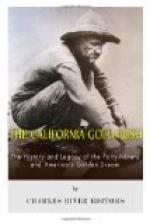The following quotation from a contemporary writer is interesting and illuminating. “A vast cloud of dust appeared at first, and thence in long files emerged this wildest of wild parties. Fremont rode ahead, a spare active looking man, with such an eye! He was dressed in a blouse and leggings, and wore a felt hat. After him came five Delaware Indians who were his bodyguard. They had charge of two baggage-horses. The rest, many of them blacker than Indians, rode two and two, the rifle held by one hand across the pummel of the saddle. The dress of these men was principally a long loose coat of deerskin tied with thongs in front, trousers of the same. The saddles were of various fashions, though these and a large drove of horses and a brass field gun were things they had picked up in California.”
Meantime, the Americans who had collected in Sonoma, under the lead of William B. Ide, raised the flag of revolution—“a standard of somewhat uncertain origin as regards the cotton cloth whereof it was made,” writes Royce. On this, they painted with berry juice “something that they called a Bear.” By this capture of Sonoma, and its subsequent endorsement by Fremont, Larkin’s instructions—that is, to secure California by quiet diplomatic means—were absolutely nullified. A second result was that Englishmen in California were much encouraged to hope for English intervention and protection. The Vallejo circle had always been strongly favorable to the United States. The effect of this raid and capture by United States citizens, with a United States officer endorsing the action, may well be guessed.
Inquiries and protests were lodged by the California authorities with Sloat and Lieutenant Montgomery of the United States naval forces. Just what effect these protests would have had, and just the temperature of the hot water in which the dashing Fremont would have found himself, is a matter of surmise. He had gambled strongly—on his own responsibility or at least at the unofficial suggestion of Benton—on an early declaration of war with Mexico. Failing such a declaration, he would be in a precarious diplomatic position, and must by mere force of automatic discipline have been heavily punished. However the dice fell for him. War with Mexico was almost immediately an actual fact. Fremont’s injection into the revolution had been timed at the happiest possible moment for him.




